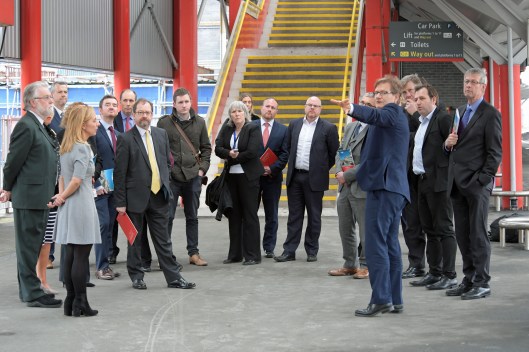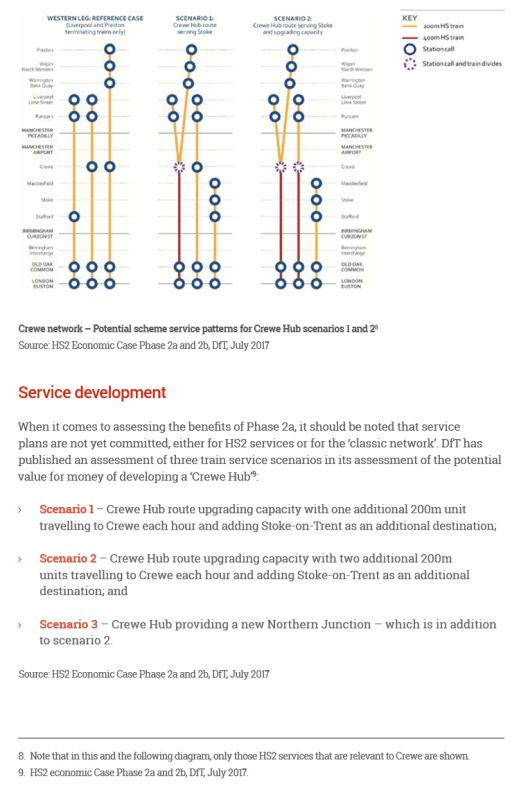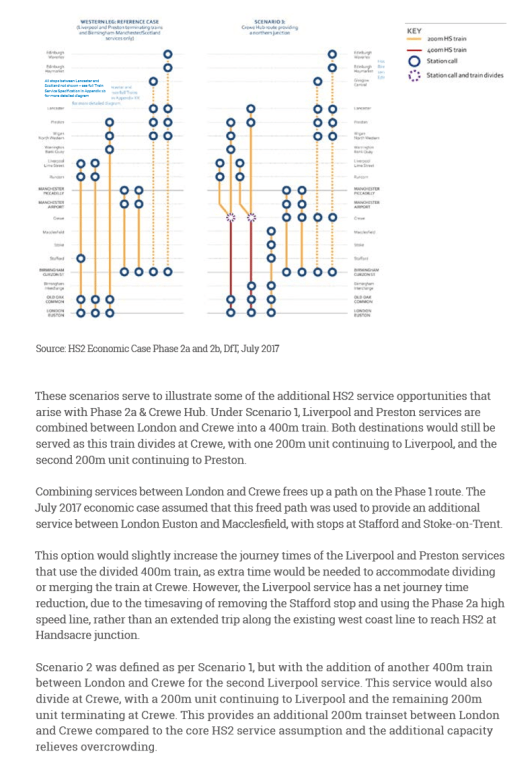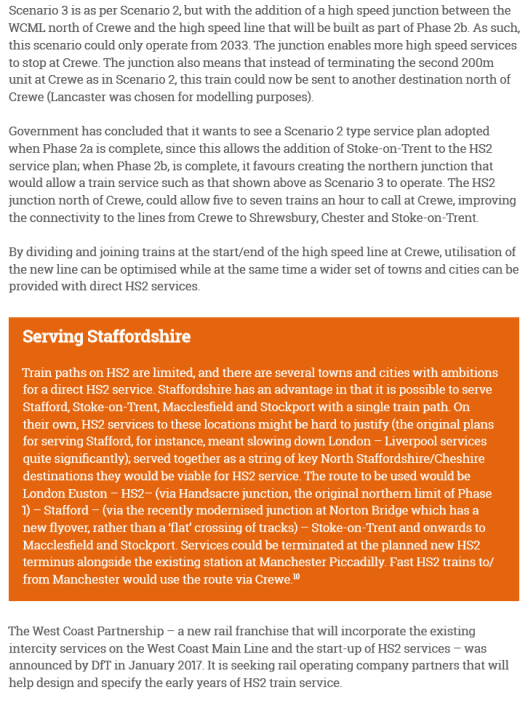Tags
Yesterday I was in Crewe to attend the launch of a new report into how the Midlands and North-West can unlock the economic and transport opportunities presented by phase 2a of Hs2 which is due to reach Crewe by 2026. The report was commissioned by the High Speed Rail Industry Leaders group (HSRIL). You can download it from the website via this link.

Guests at the launch of the report included Councillor Rachel Bailey, Leader of Cheshire East Council. Councillor Paul Yates, Leader of Crewe Town Council. Phillip Cox, CEO of Cheshire and Warrington LEP. Paul Colman, CEO of South Cheshire Chamber of Commerce and Jims Steer of Greengauge 21 which authored the report.
The report outlines how, when Sir David Higgins became Hs2 Ltd’s Chairman in 2014 he suggested accelerating Phase 2, bringing the line to Crewe 6 years earlier than planned (to 2027 from 2033). This resulted in the Government agreeing to bring forward a second Hybrid Bill for what became known as Hs2 Phase 2a. In January, the bill passed 2nd reading by an overwhelming majority (295 to 12 against).
Another chapter of the report deals with the Crewe Hub scheme, which was agreed by the Government in March 2018. In the past there were several different proposals for Crewe. At one time Network Rail were suggesting building a new station further South on the site of the Basford Hall marshalling yard. This met with local political opposition.
In July 2017 the Government published a consultation on the idea of the Crewe hub. The outcome was published on March 9th
Now the Crewe hub scheme has agreement from all sides. It doesn’t form part of the Hs2 Phase 2a Hybrid Bill, instead it’ll be created through a partnership of Network Rail, Cheshire East Council and Cheshire and Warrington Local Enterprise Council (LEP).
The plan is to create a strategic interchange that will allow the whole of Cheshire, North Staffordshire, North Wales and the Mersey-Dee area to benefit from Hs2 at the earliest opportunity. In total, this sub-region has a population of more than 1.5 million whilst around 5 million live within an hour of the station. It’s worth remembering that by 2013/14, Crewe accounted for more London-bound passengers than Warrington, Stafford, Chester or Stafford, yet the facilities don’t measure up. In 2016-17 the station was used by 3.086 million people, plus an additional 1.476 million interchange passengers.
The redesigned station would allow 400m long Hs2 trains to divide and join at Crewe. Service plans aren’t yet finalised but options suggested are for one set serving Lancaster/Preston and another Stoke-on-Trent (and possibly Macclesfield, Stockport and Manchester) to split/join at Crewe, thus only using one Euston path instead of two.
The locations for the 400m platforms are on two sites. One would be an extension of the existing platform 5, the other proposal would be a platform on the Manchester Independent (freight) lines to the West of the existing station although Network Rail are examining if reinstating the old platform 13 would be an affordable alternative as this would address concerns by freight operators worried that paths through the area may be lost.
In order to link the different sites together and make the station a modern gateway to the town the plan is to build a transfer deck across the site. Grimshaw Architects have been looking at a design for the new station which will keep and enhance the historic parts of the site whilst sweeping away much of the later clutter. At the moment station access is limited and causes traffic congestion as most people use the entrance from the Nantwich Rd over bridge which is a busy link road and the only one across the site. Station car parking is also an issue as the main station car-park is North-West of the site, where the old Crewe North Loco shed was. The plan would include moving this to the Eastern side of the station in a new multi-storey car park, freeing up the Nantwich Rd bridge for other traffic. The transfer deck would create a new link from Weston Rd on the East and (possibly) Gresty Rd and the Crewe Alexandra football ground on the West.

After the launch, guests were given a guided tour of the station to see what works were proposed.
The consultation also agreed a change to the design of the southern connection from HS2, so that HS2 joins (and takes over) the central two lines on the existing network.
The report also mentions that a junction north of Crewe, enabling HS2 trains to call at Crewe and then re-join the HS2 main line, as part of Phase 2b would be needed to allow Crewe station to support the Constellation Partnership’s ambition of 5–7 HS2 trains per hour calling at Crewe and frequencies of 3-4 trains per hour on each of the regional links.
Included in the report are details of the economic appraisal.

There’s also potential service patterns.



I’m not going to go into all the economic data contained in the report as I’m concentrating more on the rail aspects, but it does contain details of the Northern Gateway Development Zone and business opportunities and development as well as plans to create 100,000 new homes and 120,000 jobs.
The report’s a useful document for drawing together the ambitious plans for the Crewe hub and the benefits Hs2 phase 2a brings, not just to Crewe but also to the routes that radiate from the station. Work is expected to begin and be funded from Network Rail’s control period CP6 (2019-2024) as most of what is proposed is within the existing railway footprint.
It’s great to see that, after all the years of wrangling over the future of the station, Hs2 has provided a catalyst that’s brought the parties together around a firm proposal. As someone who’s known Crewe station since the early 1970s and watched its decline all the way through the 1990s to the present I’m looking forward to the new plans coming to fruition.

A couple of “not quites” if you’ll forgive me …
The Independent lines platform is nothing to do with the splitting of trains, and I’m sure it won’t be 400m long! It is to give the South Wales – Manchester service a grade-separated route across the WCML. The idea has been around for a while, but HS2 increases the usage at Crewe in off-peak hours, adding to the case.
Then, I don’t think there’s any intention to serve Stoke with a portion detached at Crewe. That would be a long way round, and not serve wealthy Macclesfield. The point is that by combining an hourly Liverpool and hourly Preston train, a path (or strictly, a platform occupation at Euston) is freed for a Stafford/Stoke/Macclesfield train.
The benefit for Liverpool / Crewe is first that instead of 2 tph taking different routes and thus being at odd intervals at one end or the other, there is a proper half-hourly even-interval service, with both trains using the Phase 2A route and benefiting from its time saving. Then, by putting the Stafford stop on the new service, there is more capacity available for Liverpool and Crewe, with even the possibility of strengthening the other Liverpool service between Crewe and Euston.
Thanks for the clarifications William!
HS2 Phase 2a will terminate in a field, two miles south of Crewe. Classic compatible trains will go on to other destinations. For the existing station at Crewe there will be ‘two HS2 services stopping at Crewe station each hour, in each direction’.
There are ambitions to increase this to 5 to 7 trains per hour. HSRIL say: HS2 is not just about faster journey times – it will transform towns and communities across the country. A remodelled hub at Crewe will serve Cheshire, Staffordshire, North Wales and the Mersey-Dee area.
These lines would need to be electrified – or the classic compatible trains would have to be bi-mode.